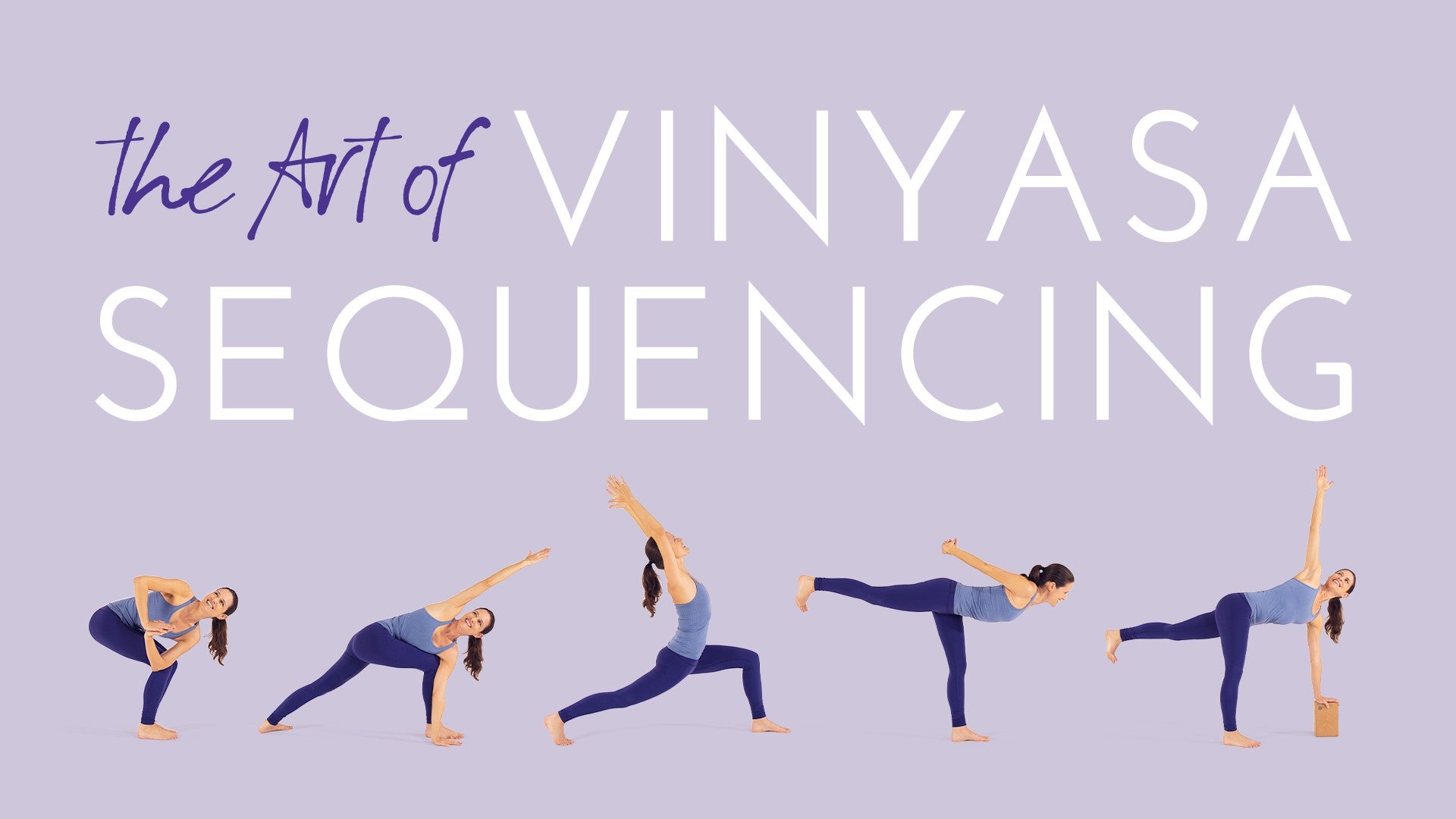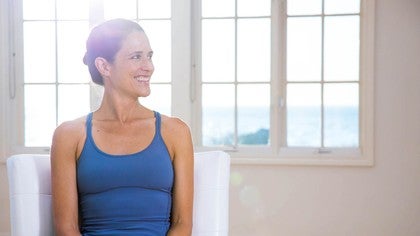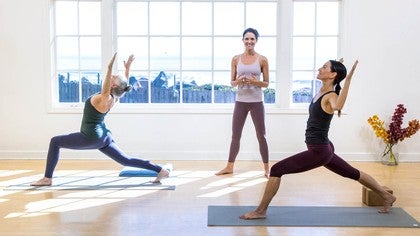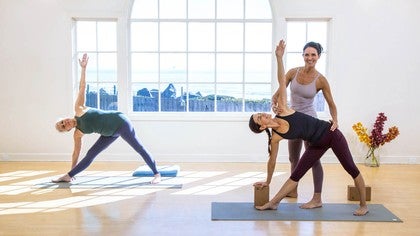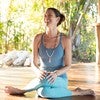Description
About This Video
Transcript
Read Full Transcript
The first thing I really love to do in establishing a class is set an intention or create the space. There are lots of different ways of languaging this, but the idea is to really mindfully transition the students from the activity they came before and invite them into their bodies and their breath. So this could happen in a simple meditation, a little pranayama, an actual setting of intention, just a very simple seated posture feeling down into the seat or child's pose. Anything that kind of slows us down, helps us drop in and land so that we're more mindful as we move into our practice. So once we've landed and set the tone, we begin by warming the body.
Really slow, intentional, simple movements. We don't want to start off with anything too intense, we don't want to jar the body physically or energetically, obviously. So I love simple cat-cow, taking time in down dog, really slow vinyasas to help people start to warm through the upper body. It's also a sweet opportunity to kind of revisit vinyasa alignment, if you offer that slowly. You could also come to hands and knees and maybe thread the needle, there are lots of options.
It's just about starting slowly and intentionally again, so the physical body has a chance to warm up and prepare for deeper, more challenging postures and so that the energetic body can start to transition and settle. So we're present and we're grounded and we're warm and then we start to move into kind of the flow of the class. Typically here, I like to work with really simple sun salutes. We start with a really basic lunge sequence and then into surya namaskara A. Depending on how long the class is, how vigorous the class is, we might add surya namaskara B, repetitions. This could be one, this could be five, it could be slow, it could be fast.
It's again, kind of what you're aiming to generate and create with the whole practice. Then after some lunging to warm up the legs, the hip flexors, the thighs, and some sun salutes, then I would move into standing poses. And of course, we can take this in a million different directions. Basic warrior two, reverse warrior triangle, side angle. We love to group those because of the open hip structure there.
We can say more about that in a moment. We can move into some standing balance postures from those fundamentals. This is the body of the class. So if you're working with some more challenging postures, if you're building into a peak pose, which we can talk about, this is where that would probably land, depending. And then I like to kind of bring it down, start to slow things a bit, definitely leaving time and space for seated postures, feeling the earth, moving all of that heat and energy we've generated into slower, deeper holds.
At this point, I think it's really useful to talk about a rich conversation that's happening in the vinyasa world right now is where to place back bending and inversions. So in my personal practice with Ashtanga roots, the back bending and the deep inversions came at the very end of the practice. Some teachers have a different orientation around it. I think it's safe to place them in a few different places in the practice. My personal preference is at the end of the kind of body of the class, the middle section, more vigorous inversions.
So like a forum stand or a handstand practice, something that's still heat building, that's using all that energy we've built through the opening and the body of the class. Whereas a shoulder stand or a headstand might come at the very end, that's more calming, more grounding, that would be safe to do at the close of the practice. Back bending, I would either place, again, very end of the middle after those more vigorous inversions, if you're offering them. Before maybe some really simple seated grounding postures, maybe even before some simple hip opening like Pidgin or Baddha Konasana, and then all the way down. Or take it through the body of the class, do some hip opening, and then complete release onto the back, a few back bends, and then you just get to stay on your back.
Move into Supta Baddha Konasana, some gentle twisting, some hip opening on the back, and then a final release. Personally, energetically, I don't love coming down onto the back and then getting back up, even if it's for seated postures. So that's my preference, but I want to make it clear that I don't think it's wrong from a safety, energetic, physical perspective to place the back bending before some seated postures and hip opening. So really, as always, feel it in your own body, see what works for you, and then place them accordingly. As we're looking at the overall flow of a practice, this is kind of a subtle point, but an important one.
It's certainly safe for the body, for the hips to open and come to neutral and open and come to neutral. We do that all day long, every day, right? However, if we're building kind of a long-standing flow within the body of the practice, kind of the middle section, I think it's most intelligent to either work with hip opening or hip neutral. For instance, inhale, lift the right leg up, exhale, open the hip to kind of prepare for that sequence, inhale, lift it, exhale, maybe take the knee outside of the elbow, which is a hip opener as opposed to the center line, which is more neutral hip, and then step into warrior two, reverse warrior, triangle, side angle, all of those poses, the hips are open versus inhale, lift the right leg up, exhale, knee to nose, again, that's that center line, hips neutral, back up, step forward into something like warrior one, high lunge, keeping that alignment through the hips, adding a twist, right? So that a whole structure within the body of the class, a whole standing sequence works either hips open or hips neutral.
And then in the next sequence, you can change it up. It's not like an entire class needs to be one or the other, but they ideally are grouped. Yeah, just giving that a little bit of thought is useful. Another aspect of sequencing within the practice is working from the most accessible, the easiest, right? Aspect of a pose into the progressively more challenging.
It's very obvious you want to warm the body slowly and intelligently. It also provides an opportunity for students who can't access other expressions of the pose to stay in that previous variation, right? So for instance, maybe you're in a low lunge, hands to the heart, take the twist with the back knee down, that's your pose. Or some students would be able to tuck the back toes, lift the back knee, start to open the arms or even move into a full bind. But we start with something accessible and orient the whole body around it, warm the hip flexors, warm the spine into the twist.
And then if it's available, build from there. Further fine tuning, obviously the breath is absolutely critical. It's our through line, it's our touchstone, it's carrying the energy, it's pacing the practice. So from my perspective, cueing the breath nearly constantly is really important so that every movement is generated by an inhale or an exhale and then is sustained by deep long steady breath. So and the more we cue it, the more we breathe, the more our students are called back to their breath over and over and over again.
As you're experimenting more and more with different sequencing, with different variations, learning more in your own body, offering more as a teacher, I think it's really important to emphasize that we teach what we know. So maybe we go to a class and we love a sequence and we just kind of jot it down or it's in the back of our brain and the next time we run into teach, we just kind of throw it out there. But we haven't practiced it, we haven't paced it, we don't really know what it feels like. Not the best idea. So always, always, always as you're developing new sequences, maybe even new little groups of postures, practice it at home, practice it with friends.
Try it out with just a few students in a more kind of laboratory setting and get some feedback around that and then bring it into a more professional setting. Layers and layers. Another really important aspect of sequencing is remembering counter poses. So if you take someone into a really deep twist, you need to offer the counter twist or just a few breaths in a really neutral spine. Another classic example is really deep back bending, needs time in a twist to either side or a really sweet, deep forward fold.
We need this physically so that the musculature of the body can balance and settle and we need it energetically. If we go somewhere really intense physically, we need time to kind of bring it to the other side, let it settle, let it ground. Once we have a pretty solid understanding of safe and intelligent sequencing, how to structure a class, hip alignment, hip rotation, a general arc of a class, where to place certain poses, how to build progressively, then we can start kind of expanding our awareness to think about the energetic experience of a class. All of those things will certainly feed into it and then there's that other kind of unseen abstract layer of what is the quality of what your students are feeling and experiencing, which for me is the most exciting, delicious, even maybe beneficial aspect of why we come to our mats. So much goes into this, I think some key elements are, of course, your own presence as a teacher.
Being present, being grounded, really engaging with your students, coming in to the extent that it's possible with an open heart, an open mind, coming with kindness and a gratitude for the practice and an awareness, this always gets me really emotional, an awareness of what an honor it is to teach yoga. Another aspect of the energetic quality is pacing and even the quality of our voice. So we start slowly kind of assuming soft quality of the voice when we're building into the middle, the peak aspect of the practice, maybe the voice gets a little stronger, a little more rapid, we're certainly cueing things more rapidly, we're building repetition and energy and then as we bring it down, again, we're slowing down, we're giving the poses time, we're giving the body time, the voice can slow it down, maybe even the volume can quiet down so that all the elements are kind of coming together to hold, to support, yeah, you know, even to nurture your students. Another way to take really good care of your students and support the flow, kind of the rhythm of the class is really clear and intentional verbal cueing, right? Not saying too much, not confusing your students with a lot of verbiage, being really clear and precise, again, carrying everything on an inhale or an exhale, being clear on direction, what's moving when, also kind of giving them a sense of how long they're in each pose or in each flow.
So yeah, we've got another three, four, five breaths here so that they can kind of gauge deeply they're going to sink into it, they can let themselves surrender or okay, I have one more breath and we're keeping the energy moving. So for the verbal cueing keeps us tied to the breath, it really helps to set the pace and then I think even on a kind of abstract level, it helps the students feel held, like I'm being taken care of, the next cue will come when it's meant to come, I can surrender into that. Your energy, your presence as a teacher is communicating so much, right? So maybe it's just being near a student, if you notice somebody is kind of struggling or fumbling or distracted and fidgeting, just kind of being near them, not in any way to be critical, just to kind of lend them your presence to remind them that you're there, to call them into presence, maybe deepening your breath around them so that they can hear that, maybe even match your breath, of course you have the opportunity to do a hands on adjustment, no words are needed there, you're communicating in a different way and this I cannot emphasize enough, especially for newer teachers, I think sometimes we feel compelled to say absolutely everything we know about a pose, which is way too much for a student to take in and really isn't necessary, right? We need to remember over and over and over again that the practice is the teacher, the poses, the experience on the mat, that is the teacher and giving a student an opportunity to experience her own body, to be in her own breath, to be in that silence and to listen for what arises, the wisdom of the body, internal source, that's ultimately what we want to be guiding people to.
So less is more, say what's needed, maybe a few little pearls that are really alive for you and then let them have their breath and their body, allow for silence. Alright so you've got your sequence, you've got all your skills, you're ready to go, you walk into class and there are four people with injuries and there are a couple people who maybe done yoga once or twice and then you've got like some advanced practitioners who want to jump up into handstand in the first 10 minutes, right? This is not atypical, right? Studios typically need to structure their classes around mixed levels, that's where it's moving. So as teachers we need to be able to adapt, right?
It's wonderful to have ideas, to create sequences, to come in with a roadmap, to be working with new material and we've got to be ready to kind of throw it out the door or at least throw sections of it out the door, meet who's there, teach to who is in your class. Which means learning variations, learning modifications, pacing slowly enough so that you can offer those, really learning language that encourages and supports people staying in those variations because of course everyone wants to reach for the maximum. And then just kind of adapting as you go. Maybe you don't offer that peak pose that day, maybe you make it sort of an overall balance flow which we'll discuss, which will serve your students better. So it's having ideas, being prepared, and then being ready to adapt and be present for what's happening.
Really teach what's alive for you, teach what you've experienced in your body. And then kind of a middle path around these. The beauty of vinyasa of course is that it's open to extreme creativity, right? This is why it was born, right? A lot of our traditional practices are fairly rigid and don't allow room to play for different bodies, for different times in life, for different energy, injury, so forth and so on.
So the beauty of vinyasa is that we can play with that creativity and work with our own expression. What we want to look out for is letting it just kind of be a free for all, right? Unintegrated, loss of alignment, loss of rhythm and pacing. We want to keep all of those fundamental principles in mind with the balance of creativity and grace and experimenting. With that in mind, this is a practice, this is about repetition, I don't think that every single class needs to be a completely new invention.
It can't be. The idea is to offer enough variety, enough variation, so that we're constantly learning and we're shifting out of pattern, however, there are some fundamentals that bear repeating. So I think sometimes as new teachers, especially in vinyasa, we feel like we have to reinvent the wheel and offer some grand entertainment every time we step into class. Ultimately, it's about being present for the practice and showing up for it over and over and over again, right? Not hanging the disco ball and blaring the pop music and making it a party, but really being present in our bodies.
So balancing that creativity, that ingenuity, experimenting with your own body in practice, but also trusting the repetition, trusting the tradition, trusting that repeating poses day in and day out is of great, great value. Also trusting yourself, know what you know, teach what you know, there's always infinitely more to learn, we're never, ever, ever done, just coming from what's alive and true and real for you in that moment and trusting that it's enough.
The Art of Vinyasa Sequencing
Comments
You need to be a subscriber to post a comment.
Please Log In or Create an Account to start your free trial.
